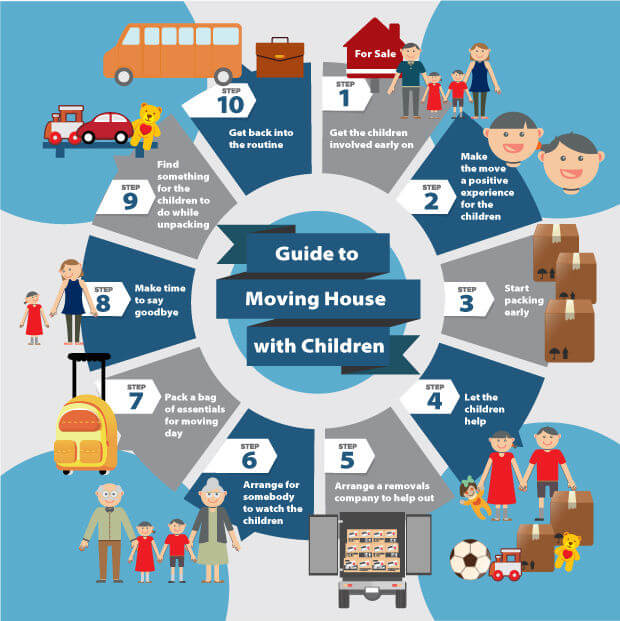
A Guide to Moving House With Children
Should you be looking to move house with children in London or even further afield, it can be a stressful experience and even more so when children are involved. It is important to make sure that the children are prepared for the move well in advance, as although it is an exciting time, moving house will impact each family member in a different way, with children more likely to have concerns about such a big change. This guide will aim to provide tips and considerations that will hopefully make the moving day go without a hitch.
Tip 1 – Get the children involved early on
The earlier on in the moving process children are involved, the more included they will feel. Where practical, try and get children involved in any decisions. The strangest things sometimes go through the minds of children, so ask what the children would like to see in the new house. These could be big things, such as whether a playroom or a larger garden are preferable, or small things, such as the colour their bedroom will be painted.
Every child will react to being told of an upcoming move in a different way, so it is important to watch out for signs of stress or anxiety so that they can be reassured. This is especially important amongst younger children, who might not understand their feelings and emotions enough to speak out about it. Explain to the child why the move is necessary, and show them photos of the new area to help familiarise them before the move .
Tip 2 – Make the move a positive experience for the children
If the move has come around by choice, then any positivity around it can be passed onto the children. If the children will be getting bigger bedrooms, or a bigger garden to play in, make a point of telling them.
The Journal of Social and Personality Psychology has noted that one of the main reasons children feel negative towards a house move is more to do with the problems that led to it, such as a divorce or job loss . Even if this is the case, try not to act stressed or upset around the children, as they will pick up on it. Try to think of something positive about the new house, and have the children focus on this. Even if it is a small thing, like they get to choose a new colour for their bedroom, it will help. Just don’t make promises that can’t be kept.
Tip 3 – Start packing early
As toys start getting put in boxes, children might start to worry that they won’t see them again. It is important to explain that the toys are just being packed so that they can have them in the new house, otherwise the child might feel that the toys have been taken away because of something they have done.
By starting to pack early, children will have plenty of time to get used to the idea of their things being packed into boxes. It is important not to take everything away too far in advance though, so leave a few favourites out until the day before the move.
Tip 4 – Let the children help
Let children help pack where possible. An older child will be able to help out much more than a younger child, however this doesn’t mean young children have to be completely excluded.
Give each child one box which can be filled with their favourite things, and tell them that they can open it as soon as you get the new house. This will help them understand that just because something has gone in the box, doesn’t mean it is gone forever . If the children want to help further, task them with packing things such as clothes, bedding and soft toys, as these things are not likely to get damaged or broken by bad packaging.
Tip 5 – Arrange a removals company to help out
A removals company will do as much or as little of the work as required. Whether it is to move boxes from one house to another, or a full packing and unpacking service, a removals company will make the move much easier. Having professionals help will not only mean the move takes much less time, it will also mean more energy for unpacking at the other end. It is always easier if the children’s rooms can be unpacked quickly, as the children will then have more time to settle in, and also somewhere to sit and play that won’t be in the way.
Tip 6 – Arrange for somebody to watch the children
There are several good reasons to have somebody watch the children on moving day. For starters, it is much safer and easier to do the packing, unpacking and moving while they are out of the way. More importantly though, moving is a big change that many children will have concerns about it. There will be so much going on though that there will not be time to give them your full attention and answer all of the questions a child might have.
For children who are anxious about the move, a family member who can explain to them what is going on would be the ideal person to spend the day with. For the less anxious child, going to a friend’s house where they can play, forget about the move and burn plenty of energy is a good option.
Tip 7 – Pack a bag of essentials for moving day
There are several items that are important to keep out for moving day, these include a kettle, some mugs, and some cleaning items. When children are involved in the move, there are many more things that can be added to that list, such as wet wipes, spare clothes and plenty of snacks. Think of it in terms of packing for a weekend away, that way, there should be a few days of essentials easily accessible.
It’s also a good idea to bring something that the children can sit and play with quietly, for example a colouring book for younger children, or a book, tablet or handheld games console for older children.
Tip 8 – Make time to say goodbye
Children will process the change better if they have the chance to say goodbye to the old house. Young children may not understand the concept of moving home, but will understand the significance of waving and saying goodbye. Older children are likely to have fond memories of the house, so having the opportunity to say goodbye will help with moving on.
If moving long distance, it is important to make sure children have time to say goodbye to any friends. Creating a picture book with photos and drawings of their friends can give a child something to look at in their new home, while older children may want to exchange phone numbers and email addresses.
Tip 9 – Find something for the children to do while unpacking
Unpacking the children’s bedrooms first will give them somewhere they can play out of the way. Older children can even help unpack their own things. If the children are particularly apprehensive about moving, consider treating them to a new toy or game for the new house, as this will give the child something positive to associate with the new house, and will provide entertainment at the same time.
Tip 10 – Get back into the routine
Children like familiarity, so once in the new home and the children’s rooms are unpacked, get back into a familiar routine as soon as possible. Having familiar toys and furniture around them will help children settle at bedtime, and try to keep to the usual mealtimes and bedtimes so that at least some things are the same .
When moving with children, it is vital that preparations for the move and the move itself go as smoothly as possible. Volition Removals are a professional agency, dedicated to making moving day go as smoothly as it possibly can.
Sources:
www.childdevelopmentinfo.com
www.phychcentral.com
www.netdoctor.com
www.phycologytoday.com
www.aacap.org


